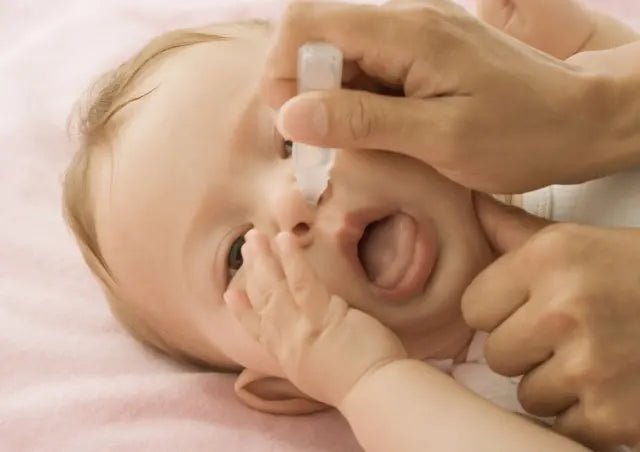
Care for a baby (Genitals, Nose, Eyes)
Share
Care for a baby's
-
Baby hygiene
- 1) Genitals:
- Penis: No consensus on the way to clean the penis of a baby male. Health professionals don't always agree on how to wash a little boy's penis. But everyone agrees that you should never forcefully pull on the foreskin. This can lead to tearing and even bleeding.
- Wash your boy's penis and scrotum with mild soap and water. Before the age of 3, the foreskin is often not detached. To clean the penis, gently pull the foreskin and wipe away the whitish discharge (smegma) that comes out of the tip of the penis. Then bring the foreskin back over the penis. Never force the foreskin when cleaning.
- Smegma: When the foreskin begins to pull away from the glans, dead cells that look like whitish discharge may come out of the tip of the foreskin. It's not pus or dirt. This is smegma. If you see such discharge under the foreskin, do not try to remove it. Wipe only those that come out of the foreskin, without forcing. This is part of normal penile development.
- Vulva: Always clean your daughter's vulva from front to back, gently spreading the labia majora. A whitish deposit may be present between the lips of the vulva. Don't try to remove it. It protects against bacteria. If stools are present between the labia minora, clean them gently. However, make sure not to go beyond the entrance to the vagina.
- Be sure to always change your baby's diaper as soon as it becomes soiled with urine or stool. This way you will prevent her buttocks, vulva or foreskin from becoming red and irritated. If this happens, apply an unscented zinc oxide ointment after each diaper change.
- Limit the use of disposable wet towels as much as possible, as they often cause irritation. Use them only when you do not have access to soap and water. Preferably, choose towels that are not scented.
- Do not use talc (baby powder). Although it was frequently used in the past to dry babies' bottoms, baby powder is no longer recommended today. It can cause breathing problems.
- 2) The nose: The method of cleaning the nose presented here is no longer a consensus, but it was in use for a long period of years, without any major problem. However, when the information will be review, we will add the new method in this blog.
- Regular nasal hygiene with saline solution has several benefits for babies. It eliminates secretions, decongests thanks to the salt and moistens the nose. It also helps prevent bleeding, colds and ear infections.
- Clean your baby's nose regularly from birth using a saline solution. This can be purchased at a pharmacy or made at home. When cleaning, secretions may come out through both nostrils or even through the mouth.
- Ideally, clean your baby's nose once a day during the summer and 2 or 3 times a day during the winter. If your baby has congestion or a cold, do not hesitate to wash his nose more often (3 to 6 times a day).
- Nappies changing is a great time to clean your baby's nose. Wash the nose of your baby under 6 months by laying him on his side. Quickly empty the contents of a syringe filled with saline solution (3 to 5 ml) into the upper nostril. Then turn your baby over and start again in the other nostril.
- If your child is older than 6 months, put 5 to 8 ml of saline solution in the syringe and sit him down to wash his nose.
- If your baby has a blocked nose with secretions, clean his nose before letting him drink, eat or sleep. Take a long bath or shower with your baby can help in this situation. Water and water vapour can make secretions more liquid, and therefore help clear the nose.
- Homemade saline solution recipe:
-
Dissolve 10 ml (2 teaspoon) of salt in 1 litre (4 cups) of cooled boiled water.
- Add 2.5 ml (1/2 teaspoon) of baking soda.
- You can cut the recipe in half, as long as you respect the proportions.
- Wash a small bottle in hot, soapy water.
- Rinse the bottle thoroughly with some of this saline solution, then fill it with this salt-water solution.
- To avoid contamination, each baby should have their own bottle.
- Store the rest of the prepared solution in a clean, closed glass container in the refrigerator for up to 7 days. You will fill your baby's bottle with this solution during the week.
- Keep the small bottle at room temperature to avoid applying cold water to your child's nose. After 24 hours out of the refrigerator, the solution should be discarded.
-
3) The eyes: Clean your baby's eyes with a clean, damp wash cloth. Always move from the inner corner of the eye (near the nose) to the outer corner (near the cheek).
Use different parts of the wash cloth for each eye.
This will prevent you from spreading any minor infection that may be present.
-
Don't worry if your baby has one corner of his eye regularly covered with white or yellowish discharge. This is probably because his tear duct is not yet unblocked. This will be resolved within a few months.
-
See a healthcare professional if you notice redness in or around your baby's eye, or discharge from the eye (pus).
Please Help Us:
If you would like to encourage us to continue publishing articles, please visit our site Jem-wellness.com, whose niche is health and well-being. We sell a lot of baby products too in the health care catalogue. Many of our products are intended to be used to combat illness or disability.
Thank you to buy on our shop.
